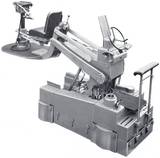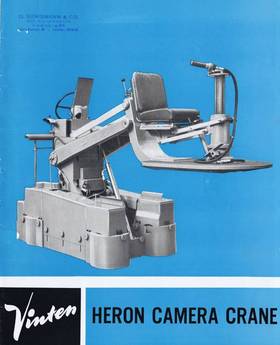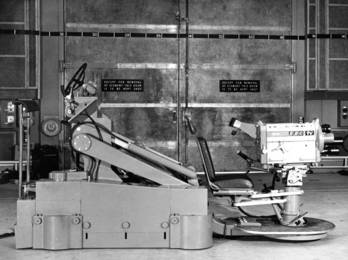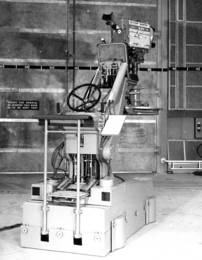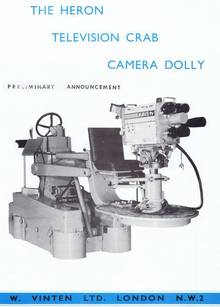Mit dem Vinten Kamera Kran "HERON" setzte der Engländer Bill Vinten Maßstäbe.
Film- und Fernsehkameras sind sehr erschütterungsempfindlich. Darum sind die besten Stative (vor allem für lange Tele- und Zoom- Brennweiten) immer noch die schweren massigen Boliden. Bei den Kränen ist das ganz besonders wichtig, weil da meist der Kranführer (der "Steuermann") und der Kameramann (oft mit dem Assistenen) drauf sitzen und rumwackeln. Dieser HERON wog darum auch eine volle Tonne und stand wie ein Betonklotz auf dem Studioboden. Hier der original englische Wortlaut.
.
THE VINTEN HERON CAMERA CRANE
The Heron Camera Crane is a power-operated studio vehicle for operation by a crew of two people. It incorporates the design experience gained during many years' work with powered camera mountings and takes advantage of the latest developments in the field of hydraulics; these have been applied in such a way as to produce a machine which is quite certainly more advanced, more versatile and smoother in operation than any other so far available, and which is capable of satisfying the exacting demands of future television studios.
Close co-operation with professional cameramen and dolly operators has been maintained throughout the design of the Heron and their practical experience has been particularly noted in the layout and mode of operation of the controls. Handling is thus precise and virtually instinctive for both tracker and cameraman ; overall noise has been reduced to an entirely acceptable minimum by the use of hydraulic power; camera and cameraman's seat movements are completely separated. These and many other points of careful detail design make the Heron as nearly as possible the ideal studio vehicle.
The need for a crew of only two men confers several advantages. Beside the obvious economic benefits resulting from the reduced manpower requirement, much closer co-operation is possible between tracker and cameraman than between the three or even four men needed to operate conventional equipment.
These advantages are now available from a studio vehicle which at the same time offers the full manoeuvrability previously associated only with larger and more orthodox cranes. With both steering and crabbing immediately available there is no limitation on control of the camera platform in any plane: complete freedom of movement can thus be combined with a compact, economic layout.
CAMERAMAN
The cameraman has sensitive control of camera platform elevation, through a twist grip mounted on the pan bar. This operates quite independently of normal pan and tilt movements. The pan and tilt head is mounted on a central column which can be hydraulically raised and lowered over 12 inches; the operating valve is under the control of the cameraman.
This movement enables the camera height to be set to the most convenient and comfortable position and can also be used to increase the extent of overall camera movement, allowing extra high and low shots to be obtained.
The cameraman's seat is separately adjustable for height and for fore and aft position. It also swings around the central column, being controlled by the cameraman's feet against the platform; this rotary movement is quite independent of panning movements and enables the operator to reposition himself and his seat without in any way disturbing the camera.
The platform is arranged to allow the cameraman to stand for shots requiring large angles of downward tilt; together with the freedom of action conferred by the various adjustments and controls, this provides the cameraman with every opportunity to exploit a wide range of angles in comfort.
TRACKER
The tracker stands on an elevated platform at the rear of the Crane and controls all movements of the vehicle. Duplicated control levers for right and left-handed operation enable the speed and sense (forward and reverse) of traction to be controlled.
A steering wheel at the top of the control pedestal turns all four wheel units in crabbing, or the rear pair only in steering; the latter conditions introduces automatically a patented compensation system to maintain perfect steering geometry.
Changeover between crabbing and steering is effected by depression of one or other pedal on a pivoted bar, using the left foot. This pedal may be preselected, the changeover taking place only when the steering is aligned fore and aft.
Braking, by four powerful drum brakes, is obtained by pressure on a pedal, using either foot. Both braking and driving loads are equalised about the vehicle centre line at all times, irrespective of direction of movement, in crabbing or steering.
The control pedestal contains panels supporting the minor controls. These comprise a key-operated main switch, indicator lamps, fuses, hydraulic systems pressure gauge, an elevator arm safety button and a pump speed switch.
The latter enables the hydraulic pump to be run at slow speed or high, according to the demand being made on the power stored in the hydraulic accumulator.
SAFETY DEVICES
The elevator arm safety button enables the tracker from his more commanding viewpoint to override any potentially dangerous vertical movements initiated by the cameraman.
The tracker's platform pivots slightly under his weight to operate a "dead man's valve". This ensures that traction power can be applied only when the tracker is riding on the vehicle in his correct position. To safeguard the Heron when it is left unattended, the platform may be locked in the inoperative position. A screw-down valve is fitted which disconnects the elevator arm operating circuit, again to prevent unauthorised use when the Heron is unattended. Both these safety devices are desirable since hydraulic power is stored in an accumulator even when the main electrical supply is disconnected. The final safeguard is interruption of the electrical supply to the pump motor by means of the ignition-type key switch.
This view emphasizes the compact layout of the Heron. The camera support column is shown fitted with the Vint en Pan and Tilt Head.
CONSTRUCTION
The Heron is based on a very strong steel box chassis containing the major hydraulic components; the camera platform and column, and the elevator arm, are cast in magnesium alloy. This ensures an extremely rigid type of construction with a low centre of gravity. The Heron is supported on four wheel units at the corners. Two diagonally opposite units are motorised while the other two wheel units are braked. This diagonal arrangement of both traction and braking is responsible for the equal accelerating and decelerating loads about the crane centre line, irrespective of direction of movement.
The brakes are mechanically operated automobile type drum brakes, one to each of the four braked wheels. The motors are low speed hydraulic units which, in effect, form the wheel hubs. Since they drive the wheels directly there is no reduction gear or chain drive to produce noise or require attention. Hydraulic power is stored in an accumulator which caters for fluctuating loads; it is also capable of driving the Heron up to 110 feet (33 m) when fully charged, without power being connected to the pump driving motor. This is a useful facility for moving the crane between studios where a trailing cable would be an embarrassment.
The hydraulic pump is fully submerged within its reservoir, so that free fluid damps vibration and noise; this makes the Heron almost completely silent in operation. The elevator arm is moved by a ram energised through a simple remote control system.
The complete hydraulic system is unobtrusive, extremely reliable and requires virtually no maintenance.
SPECIFICATION
*Power supply 230V a.c. 3 phase (A transformer is available to permit operation of the Heron from all standard mains supply voltages. Weight of transformer 188 lb. (85 kg))
Maximum power requirement 2kVA (1 1/2 h.p. motor)
Hydraulic pressure range 825-1060 p.s.i. (58-0-74-5 kg.cm2)
Weight (without Pan and Tilt Head) 2260 lb. (935 kg)
Maximum height to camera mounting head plate 90 in. (228 cm)
Minimum height to camera mounting head plate 22 in. (55 cm)
Maximum length with elevator arm fully depressed 122 in. (310 cm)
Overall length of chassis 73 in. (185 cm)
Overall width of chassis 36 in. (91 cm)
Maximum space between vertical walls needed to complete a 180° turn. 84 in. (214 cm)
W.VINTEN LIMITED
715, NORTH CIRCULAR RD., CRJCKLEWOOD, N.W.2. TELEPHONE: GLADSTONE 6373
Preliminary Information
"Special Features"
HYDRAULIC OPERATION
On Traction.
On Jib Arm.
On Camera Column*
The power is provided by hydraulic storage accumulator maintained by 230V 3phase motor pump unit mounted in the vehicle suitably blimped.
TRACTION
By two hub mounted hydraulic motors, disposed diagonally opposite one another providing directional stability when crabbing, These motors provide good control, silence, speed and acceleration.
CRABBING & STEERING
Four wheel crabbing or normal steering can be preselected. Unlike motor car type steering, there is no limit to lock when in steering position and this feature has been extended to crabbing.
JIB CONTROL
By positional servo with preset controls for acceleration and maximum velocity. Pan bar mounted twist grip.
CAMERA COLUMN
The camera is mounted on an extendable column and is independent of the cameraman's seat. The seat movements are, therefore, not transmitted to the camera.
SAFETY FEATURES
Trackers platform operates dead man's valve. Tracker has overriding control of jib movements for emergency. Brakes will stop crane even with motors at full power.
A further trip situated on tracker's platform immobilises crane perventing use by unauthorised persons. Fully enveloping adjustable cable guards.
SPECIFICATION
Maximum Lens height subject to camera 8' 6" (258cms)
Minimum Lens height subject to camera 2' 10" (85cms)
Maximum Length (Jib lowered) 10' 2" (310cms)
Chassis length 6' 1" (l85cms)
Width 3' 0" (91cms)
Maximum Camera Column Extension 12" (30cms)
Electric Supply required: 230 Volts A.C. 3 Phase 6 Amps.
.

